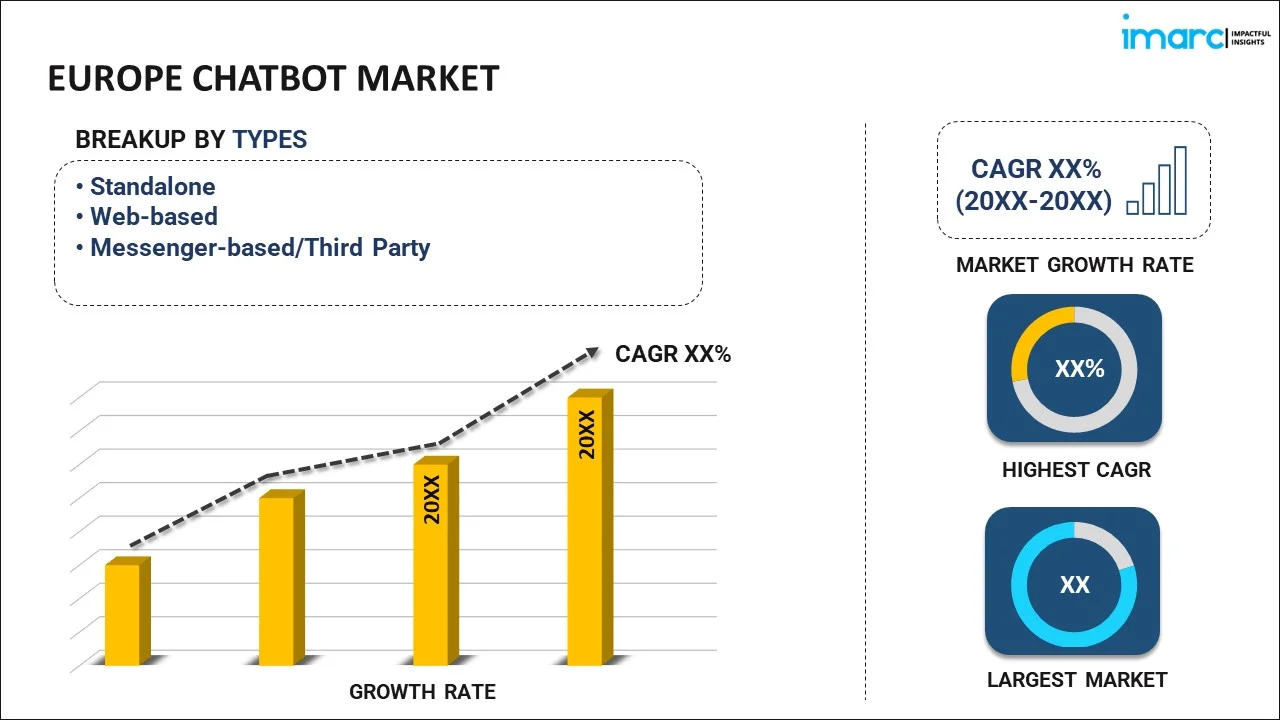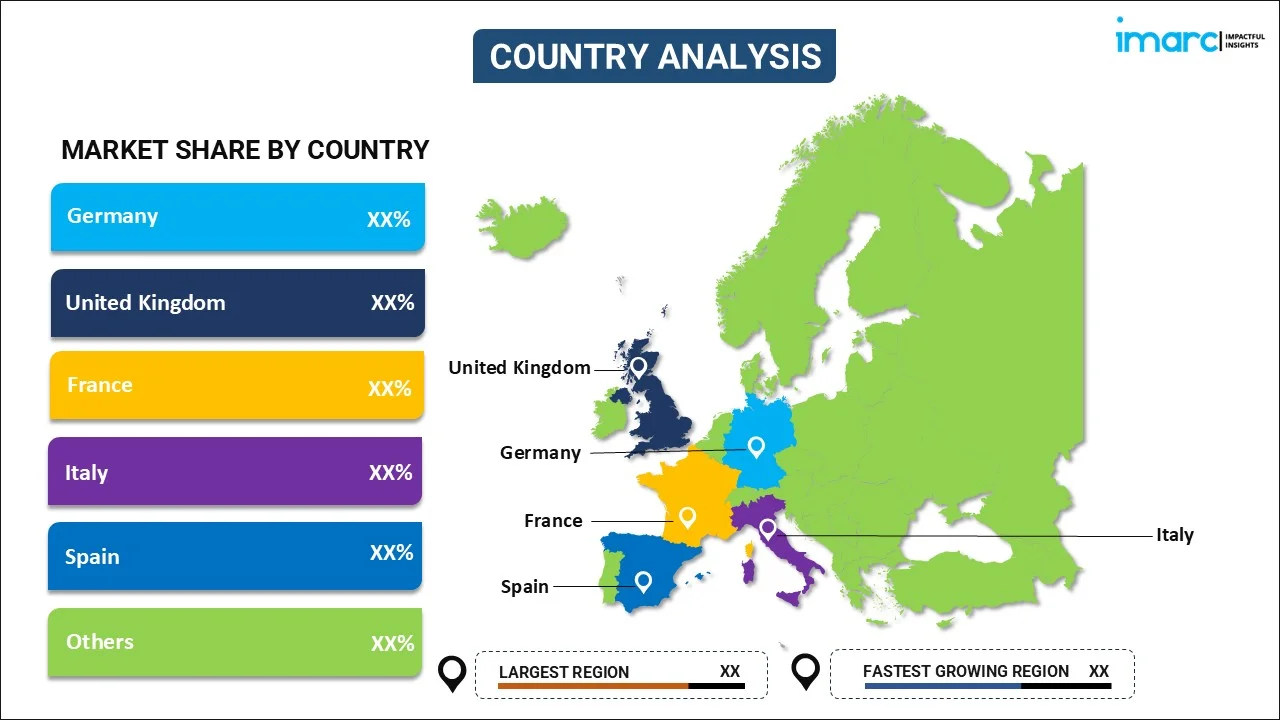
Europe Chatbot Market Report by Type (Standalone, Web-based, Messenger-based/Third Party), Product (Artificial Intelligence, Marketing, Human Intelligence), Application (Bots for Service, Bots for Social Media, Bots for Payments/Order Processing, Bots for Marketing, and Others), Organization Size (Small Enterprises, Medium Enterprises, Large Enterprises), Vertical (Healthcare, Retail, Banking, Financial Services, and Insurance, Media and Entertainment, Travel and Tourism, E-Commerce, and Others), and Country 2025-2033
Market Overview:
The Europe chatbot market size reached USD 1.8 Billion in 2024. Looking forward, IMARC Group expects the market to reach USD 8.4 Billion by 2033, exhibiting a growth rate (CAGR) of 18.5% during 2025-2033. The growing need for advanced, scalable customer service solutions within various end-use industries, the rising emphasis on personalization, consumer engagement, and real-time response, and the integration of cutting-edge technologies with chatbots represent some of the key factors driving the market.
|
Report Attribute
|
Key Statistics
|
|---|---|
|
Base Year
|
2024
|
|
Forecast Years
|
2025-2033
|
|
Historical Years
|
2019-2024
|
|
Market Size in 2024
|
USD 1.8 Billion |
|
Market Forecast in 2033
|
USD 8.4 Billion |
| Market Growth Rate 2025-2033 | 18.5% |
Chatbots are artificial intelligence-powered conversational tools designed to mimic human-like interactions through text or voice interfaces. These sophisticated computer programs exhibit characteristics such as understanding natural language, simulating human conversation, adapting to user preferences, and providing immediate, context-aware responses to queries. The underlying working mechanism of chatbots relies on complex algorithms, machine learning, and natural language processing (NLP), enabling them to interpret, analyze, and respond to human input in a seamless manner. Some essential properties include their ability to be integrated into various platforms such as websites, mobile apps, and social media channels, and their adaptability to the context of the conversation. Moreover, they can handle multiple inquiries simultaneously, learn from previous interactions, and offer personalized responses. Some of the advantages of chatbots include enhancing customer engagement, cost-effectiveness, the ability to process vast amounts of information in a smaller timeframe, support to automating routine tasks and contributing to data-driven decision-making.
Europe Chatbot Market Trends:
The market in Europe is primarily driven by the growing need for advanced, scalable customer service solutions within various end-use industries. In line with this, the rising emphasis on personalization, consumer engagement, and real-time response is also providing an impetus to the market. Moreover, the integration of cutting-edge technologies such as artificial intelligence (AI), machine learning (ML), and cognitive computing with chatbots is acting as a significant growth-inducing factor for the market. In addition to this, the ongoing investments in research, innovation, and technological advancement within the European technology sector are resulting in higher adoption rates across different verticals, both in public and private domains. Besides this, the proliferation of small and medium-sized enterprises (SMEs) adopting chatbots to enhance customer interaction and compete with larger corporations is creating lucrative opportunities in the market. Also, the increasing focus on data security, privacy concerns, and regulatory compliance within the European Union is impacting the market positively. The market is further driven by supportive government initiatives promoting digital transformation, encouraging the startup ecosystem, and facilitating the implementation of AI-based solutions. Apart from this, the rapid shift towards automation in customer support, coupled with the growing trend of mobile commerce, online shopping, and the emergence of virtual shopping assistants, is propelling the market. Some of the other factors contributing to the market include the development of multilingual chatbots catering to Europe's diverse linguistic needs, strategic collaborations between tech companies and industry-specific businesses, a robust focus on enhancing the overall user experience, and the rise of innovative business models leveraging chatbot technology.
Europe Chatbot Market Segmentation:
IMARC Group provides an analysis of the key trends in each segment of the Europe chatbot market report, along with forecasts at the regional and country levels for 2025-2033. Our report has categorized the market based on type, product, application, organization size, and vertical.
Type Insights:

- Standalone
- Web-based
- Messenger-based/Third Party
The report has provided a detailed breakup and analysis of the market based on the type. This includes standalone, web-based, and messenger-based/third party.
Product Insights:
- Artificial Intelligence
- Marketing
- Human Intelligence
The report has provided a detailed breakup and analysis of the market based on the product. This includes artificial intelligence, marketing, and human intelligence.
Application Insights:
- Bots for Service
- Bots for Social Media
- Bots for Payments/Order Processing
- Bots for Marketing
- Others
A detailed breakup and analysis of the market based on the application has also been provided in the report. This includes bots for service, bots for social media, bots for payments/order processing, bots for marketing, and others.
Organization Size Insights:
- Small Enterprises
- Medium Enterprises
- Large Enterprises
A detailed breakup and analysis of the market based on the organization size has also been provided in the report. This includes small enterprises, medium enterprises, and large enterprises.
Vertical Insights:
- Healthcare
- Retail
- Banking, Financial Services, and Insurance
- Media and Entertainment
- Travel and Tourism
- E-Commerce
- Others
A detailed breakup and analysis of the market based on the vertical has also been provided in the report. This includes healthcare, retail, banking, financial services, and insurance, media and entertainment, travel and tourism, e-commerce, and others.
Country Insights:

- Germany
- France
- United Kingdom
- Italy
- Spain
- Others
The report has also provided a comprehensive analysis of all the major regional markets, which include Germany, France, United Kingdom, Italy, Spain, and others.
Competitive Landscape:
The report has also provided a comprehensive analysis of the competitive landscape in the market. Competitive analysis such as market structure, key player positioning, top winning strategies, competitive dashboard, and company evaluation quadrant has been covered in the report. Also, detailed profiles of all major companies have been provided.
Europe Chatbot Market Report Coverage:
| Report Features | Details |
|---|---|
| Base Year of the Analysis | 2024 |
| Historical Period | 2019-2024 |
| Forecast Period | 2025-2033 |
| Units | Billion USD |
| Scope of the Report | Exploration of Historical and Forecast Trends, Industry Catalysts and Challenges, Segment-Wise Historical and Predictive Market Assessment:
|
| Types Covered | Standalone, Web-based, Messenger-based/Third Party |
| Products Covered | Artificial Intelligence, Marketing, Human Intelligence |
| Applications Covered | Bots for Service, Bots for Social Media, Bots for Payments/Order Processing, Bots for Marketing, Others |
| Organization Sizes Covered | Small Enterprises, Medium Enterprises, Large Enterprises |
| Verticals Covered | Healthcare, Retail, Banking, Financial Services, and Insurance, Media and Entertainment, Travel and Tourism, E-Commerce, Others |
| Countries Covered | Germany, France, United Kingdom, Italy, Spain, Others |
| Customization Scope | 10% Free Customization |
| Post-Sale Analyst Support | 10-12 Weeks |
| Delivery Format | PDF and Excel through Email (We can also provide the editable version of the report in PPT/Word format on special request) |
Key Questions Answered in This Report:
- How has the Europe chatbot market performed so far and how will it perform in the coming years?
- What has been the impact of COVID-19 on the Europe chatbot market?
- What is the breakup of the Europe chatbot market on the basis of type?
- What is the breakup of the Europe chatbot market on the basis of product?
- What is the breakup of the Europe chatbot market on the basis of application?
- What is the breakup of the Europe chatbot market on the basis of organization size?
- What is the breakup of the Europe chatbot market on the basis of vertical?
- What are the various stages in the value chain of the Europe chatbot market?
- What are the key driving factors and challenges in the Europe chatbot market?
- What is the structure of the Europe chatbot market and who are the key players?
- What is the degree of competition in the Europe chatbot market?
Key Benefits for Stakeholders:
- IMARC’s report offers a comprehensive quantitative analysis of various market segments, historical and current market trends, market forecasts, and dynamics of the Europe chatbot market from 2019-2033.
- The research study provides the latest information on the market drivers, challenges, and opportunities in the Europe chatbot market.
- Porter's five forces analysis assist stakeholders in assessing the impact of new entrants, competitive rivalry, supplier power, buyer power, and the threat of substitution. It helps stakeholders to analyze the level of competition within the Europe chatbot industry and its attractiveness.
- Competitive landscape allows stakeholders to understand their competitive environment and provides an insight into the current positions of key players in the market.
Need more help?
- Speak to our experienced analysts for insights on the current market scenarios.
- Include additional segments and countries to customize the report as per your requirement.
- Gain an unparalleled competitive advantage in your domain by understanding how to utilize the report and positively impacting your operations and revenue.
- For further assistance, please connect with our analysts.
 Request Customization
Request Customization
 Speak to an Analyst
Speak to an Analyst
 Request Brochure
Request Brochure
 Inquire Before Buying
Inquire Before Buying




.webp)




.webp)












